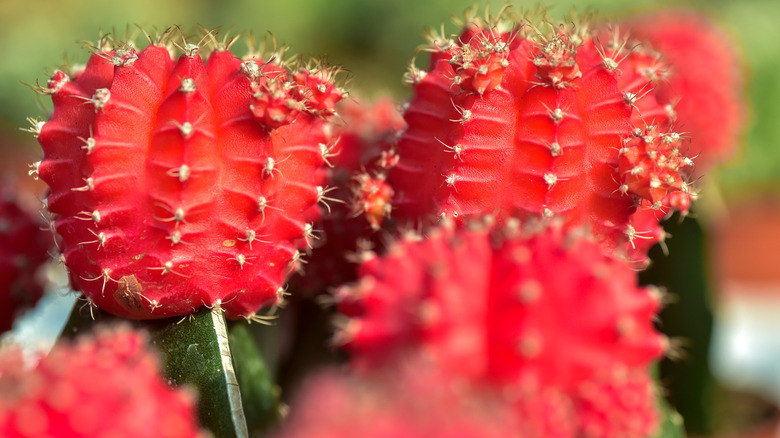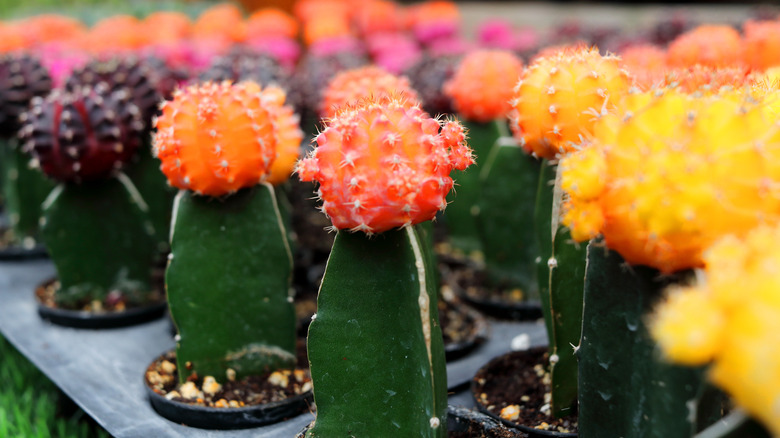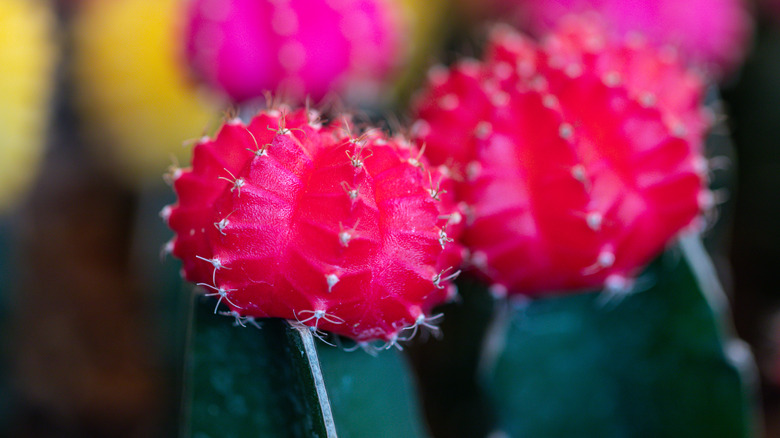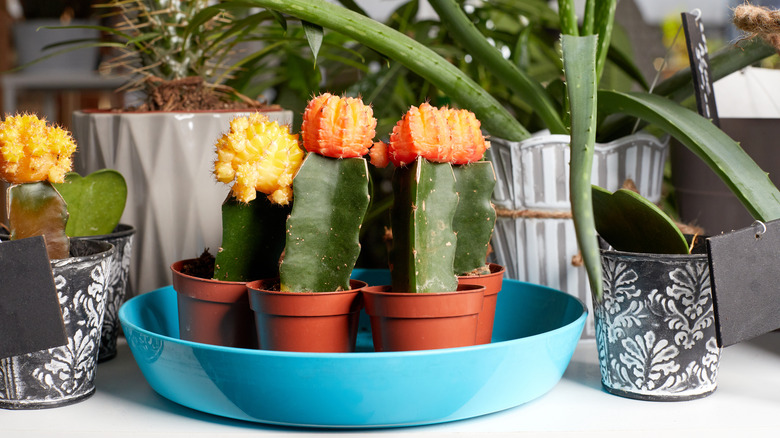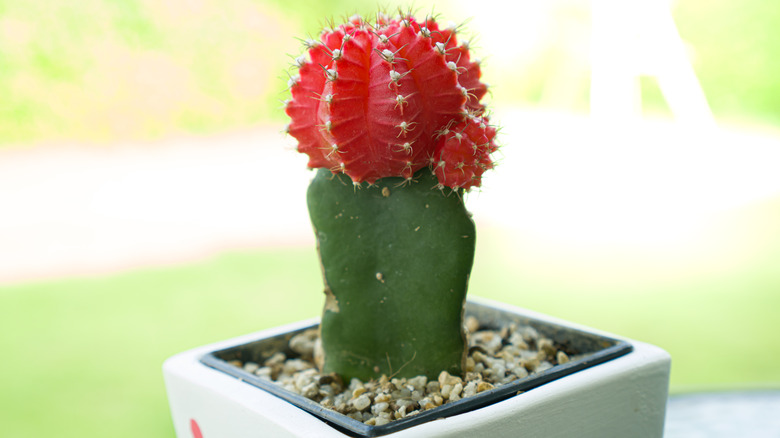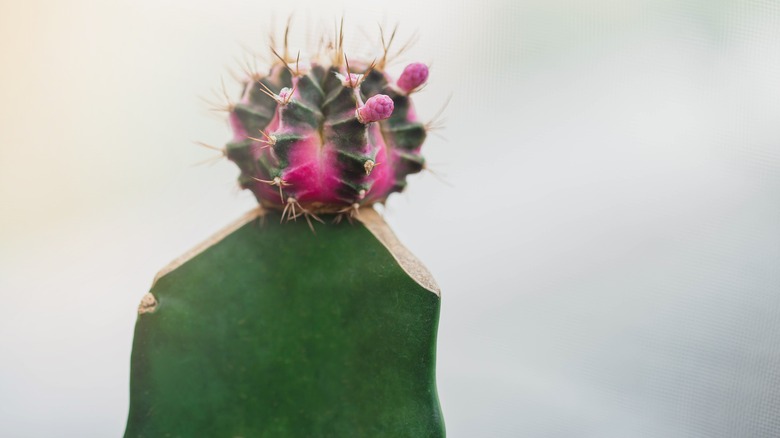How To Care For A Grafted Moon Cactus
The moon cactus (Gymnocalycium mihanovichii), also commonly referred to as the ruby ball cactus, is a species native to South America. As explained by The Spruce, moon cacti are most often grafted on top of other species of cacti, such as Hylocereus. Therefore, the top, colorful part of the plant is the only section that is true Gymnocalycium mihanovichii.
Moon cacti are characterized by a lower cactus that is always green and often with few spines and an upper cactus that may be yellow, red, orange, pink, or burgundy. According to About Succulents, the colorful ball-shaped cactus on top feeds off of the lower host cactus. Bright Gymnocalycium mihanovichii are actually albino, meaning they can't produce their chlorophyll; due to this parasitic relationship between the two cacti, the plant cannot live much longer than two or three years. However, during these few years, the moon cactus is relatively easy to grow. Like many other species of succulents and cacti, it doesn't need much attention or water to survive.
How to use a grafted moon cactus in garden
Grafted moon cacti are rarely used in the garden. They require temperatures that stay about 30 degrees Fahrenheit at all times. This means that unless you live in USDA hardiness zone 10, you won't have much luck with ruby ball cacti in your garden, as per Garden in Pots. Even the winters in these warm environments can cause these plants to die. If you have the room inside your home, you are better off growing your moon cactus as a houseplant.
If you are set on growing moon cacti in your garden, we suggest using them in combination planters or cactus gardens. They pair well with other compact succulents such as echeveria minima, gasteria "little warty," and tiger kalanchoe. Moon cacti need lots of indirect sunlight and a little water, but be sure to plant yours with cacti with similar needs. Also, try placing your combination planters in a bright spot out of direct sunlight, such as on your porch or under larger plants. Keeping these cacti in planters will allow you to bring them inside during cold nights and winters so they can live longer.
How to grow a grafted moon cactus
The easiest way to grow a grafted moon cactus is to buy it pre-grafted at your local nursery. However, if you feel up to the task of grafting a moon cactus, we will give you the steps to do just that. Before you begin, you will need some supplies. Gather gloves, rubber bands, a small pot, cactus, succulent potting mix, and a sterilized knife. You'll also need a Gymnocalycium mihanovichii pup and a host cactus; either Hylocereus trigonus or Cereus repandus, explains Lotus Magus.
Start by cutting the very top of your host cactus off to reveal a ring underneath. This ring is vital to the growth and survival of the two cacti you are grafting together. Then, slice off a bit of the bottom of your Gymnocalycium mihanovichii pup. Inside it will be another smaller ring: Carefully match the two circles together. The better they match up, the quicker the two plants become one. Next, wrap two to four rubber bands around the pot and onto the Gymnocalycium mihanovichii to keep it on top of the host cactus. After about one month, your two cacti should have grafted together, and you can remove the rubber bands. Keep in mind that there is no other way to grow or propagate the moon cactus.
How to care for a grafted moon cactus
The ruby ball cactus is an easy-to-care-for plant that only needs adequate sunlight and water to survive. However, unlike some other cacti species, this one does not appreciate direct sunlight because the top of the plant cannot properly photosynthesize due to its mutant DNA; yet, the host cactus needs sunlight to feed the parasite. It's a tricky situation! The best compromise to keep both plants happy is to put your grafted moon cactus in a bright window with indirect sunlight, as per Leafy Place. Some direct sunlight in the morning is okay, but be sure to watch for bleached spots on the ball that indicate it is getting too much sun.
Always let the soil dry out between waterings, meaning you should only saturate it once per week or so. According to About Succulents, you may not need to water this plant at all in the winter months. As for fertilization, ruby ball cacti are not big feeders. Plan to fertilize your cactus once per month during its growing season with liquid succulent plant food.
Is the grafted moon cactus toxic?
While Hylocereus is not toxic to pets, as said by the ASPCA, the case for Gymnocalycium mihanovichii isn't set out as clearly. Most pet owners assume the top of the grafted moon cactus is not a large concern. About Succulents reminds us that while it is not on the ASPCA's list of toxic plants, that doesn't mean that it isn't dangerous. It's possible that ingesting the moon cactus could lead to vomiting or other symptoms.
Despite this confusion, you should still keep your pets away from the cactus itself and the spikes on both plants. The sharp pricks on the moon cactus can penetrate the skin of humans and pets; if left untreated, the thorns can create a minor infection under the skin and could require medical attention. As with any thorny plant, keep your ruby ball cactus on a top shelf, away from pets and small children to avoid accidents and injuries.
How to repot a grafted moon cactus
The only time you may need to repot your grafted moon cactus is when you bring it home from the store. This is because these cacti are slow-growing, and their short life span means they rarely outgrow their original container. However, if you do need to repot your ruby ball cactus, this is how you should do it.
You will need gloves, succulent potting soil, and a pot not much larger than your cactus's root ball. Too large of a container will retain too much water and lead to root rot. Before repotting, ensure that the soil surrounding your plant is completely dry. With your gloves on, carefully remove your cactus from its original pot. As per The Spruce, remove the old soil from the cactus, exposing its roots. Once much of the dirt has fallen, place the plant into its new pot with fresh soil. Using your gloved fingers, press the dirt firmly around the base of the cactus to secure it in its new home. Don't water your grafted moon cactus right away. Allow it to root into its new pot and introduce it back to its regular watering schedule gradually.
Common problems with the grafted moon cactus
This strange hybrid cactus can have several problems if it isn't grafted correctly, watered properly, or given the right amount of sunlight. Too much sunlight is the most common issue and one of the easiest to correct. If your ruby ball cactus loses its color, likely direct sunlight is the culprit. Garden in Pots tells us to simply move the plant to a shadier spot in your home and watch it regain its color. Yet, if the ball turns a brown color, overwatering is probably happening, leading to root rot and other problems.
Before fixing your watering schedule, take your plant out of its container to inspect its roots; if some are brown and mushy, cut them off and repot the plant. Remember to water your grafted moon cactus only when the soil has dried out. Doing all this should allow your plant to return to good health. If the bright ball on the grafted moon cactus is beginning to detach, it has either grown too fast, too slow, or improperly on top of the host cactus, says Leafy Place. The solution to this issue is to re-graft the Gymnocalycium mihanovichii onto a new host. Reread the "How to grow a grafted moon cactus" section to learn how to do this.
